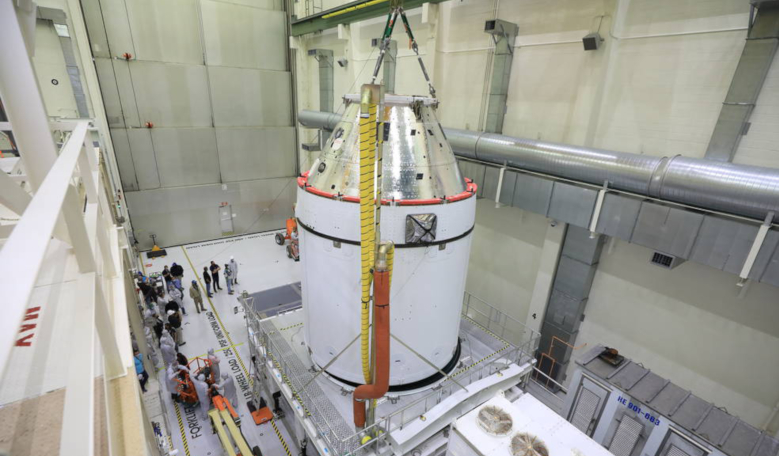Orion, NASA’s new human-rated exploration-class spaceship is ready for its mission to the Moon later this year, say prime contractor, Lockheed Martin, who have now completed assembly and testing of the craft.
With assembly complete, staff are now officially transferring the spacecraft to NASA’s Exploration Ground Systems (EGS) where it will be prepped and fuelled ready for a launch currently scheduled for November 2021.
“The handover of Orion is a big milestone for the Artemis program – it represents the culmination of years of hard work by both the Orion and the Exploration Ground Systems teams,” said Mike Bolger, EGS manager.
Orion will serve as the exploration vehicle that will one day carry astronauts to space, provide emergency abort capability, sustain the crew during the space travel, and provide safe re-entry from deep space return velocities.
Orion is equipped with a European-built service module, which will power, propel, and provide thermal control, air, and water for the spacecraft. It will be the first time that NASA has used a European-built system, provided by ESA (European Space Agency) as a critical element to power an American spacecraft.
The spacecraft’s first mission will be Artemis 1; an uncrewed flight to test the integration of the spaceship with NASA’s Space Launch System (SLS) rocket.
During Artemis 1, Orion will travel thousands of kilometres beyond the Moon, farther than any spacecraft built for humans has ever flown, on a mission that will last about three weeks.
Eventually, NASA aim to use Orion to land the first woman and the next man on the Moon during its Artemis III mission. Whether a launch date originally slated for 2024 will still be attainable remains to be seen.
Before then, Artemis II, will head to the Moon with a crew onboard, but will not descend to the lunar surface. Instead Orion’s inhabitants will orbit the Moon and return.
“I am proud of the extraordinary dedication and efforts of the many team members from the US and Europe who worked together to build Orion for the Artemis I mission. The significance of this monumental accomplishment is being realised as we steadily march toward a historic launch later this year,” said Orion Program Manager Cathy Koerner.
“The knowledge gained along the way will ensure the spacecraft will safely send astronauts on missions to the Moon, with the capability to transport humans farther into space than ever before.”
Meanwhile, NASA has also been putting the SLS through its paces this last year as the US space agency ramps up its Green Run tests amidst delays and budget concerns.
The Green Run tests are designed to validate the massive, 65 metre-tall core stage design and performance of the rocket by mimicking a real launch.
Historically, other NASA rockets built to carry astronauts have used main propulsion test articles to test the integrated engines and main propulsion system; the SLS programme on the other hand is performing the stage testing with actual flight hardware – a move the agency feels is necessary given the complexity and sheer size of the rocket.
Green Runs include testing of three flight computers, more than 50 avionics units, navigation and control systems and 29 kilometres (18 miles) of cables as part of the SLS’s propulsion systems.
Propellant will also flow through the rocket’s two propellant tanks that can hold 700, 000 gallons of cryogenic, or supercold fuel. The tanks feed four RS-25 engines that when fired simultaneously will be able to produce 1.6 million pounds of thrust.
NASA has completed seven of the eight core stage Green Run tests and following a test readiness review this week, the agency is now targeting Saturday (16 January) for its final test in the series.











